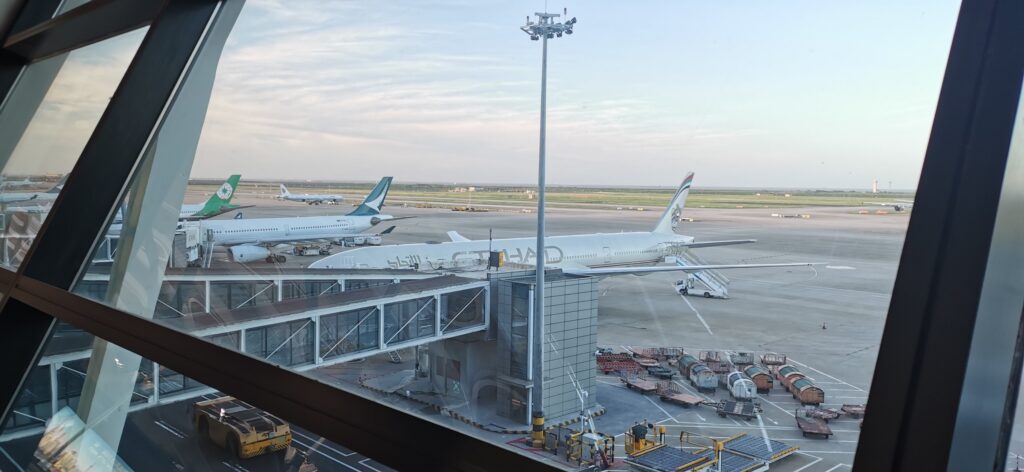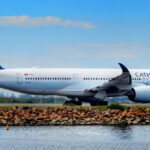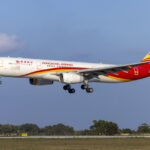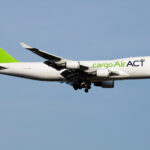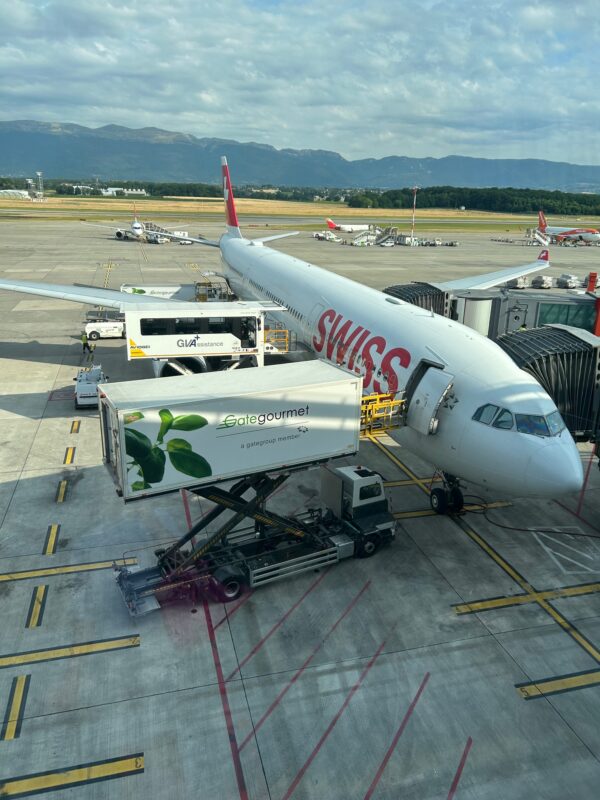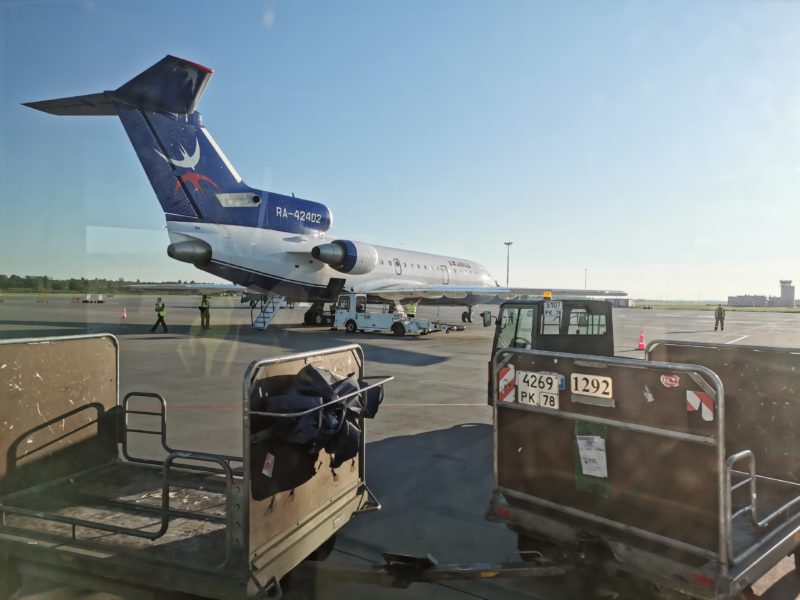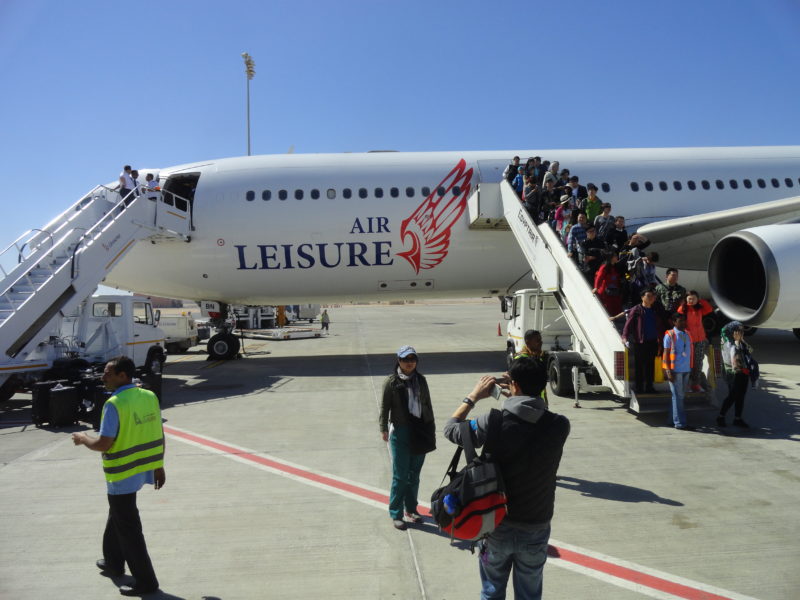Trip Report: Shanghai to Hong Kong with Cathay Pacific
Booking
After spending the better half of 2022 in Shanghai, it was time for me to return to home base in Hong Kong. Just as I had done when I flew to Shanghai in January, I booked my ticket on Cathay Pacific about a week in advance using British Airways Avios. This time, both the noontime and evening flights had ample availability in Business and Economy. I selected Economy for the short flight which set me back 10,000 Avios and $33 USD in taxes.
This past spring, Cathay Pacific adjusted its checked baggage allowances for flights between Hong Kong and mainland China. When I flew to Shanghai in January, I was allowed a generous 30 kg of baggage as an Economy class passenger, but on the return journey in August I was allowed just one piece weighing no more than 23 kg. This is still better than the 20 kg of checked baggage Hong Kong Airlines allows for Economy passengers on this route.
Pre-departure Preparations
On my last day in Shanghai, I packed my checked bag which ended up weighing 19 kg, a rollaboard weighing 9 kg (Cathay’s official limit is 7 kg, but the carry-on weights were never checked), and a small but very heavy backpack with three laptops inside. The day before, I had taken a COVID-19 PCR test at a laboratory recognized by the Hong Kong Government which would allow me to avoid being subjected to quarantine upon arrival. I also needed to make a declaration via Hong Kong’s Customs website to obtain a green QR code as well as complete an exit health declaration for China Customs, also generating a QR code.
The flight was due to depart at 7:10pm, but my ticket indicated that check-in would close 90 minutes before departure so I set off for the airport at 3pm taking Metro Line 2. There are still plenty of complicated restrictions for flying to Hong Kong, so I was glad to have extra time. As the train approached Pudong Airport, I spotted the Cathay Pacific A330-300 that I would be taking as it was on final approach.
Check in
I entered Terminal 2 just after 4pm and saw just three flights on the International Departures board. United to San Francisco via Incheon, Singapore Airlines to Changi Airport, and my Cathay flight to Hong Kong. At check-in Area D, a very long line of passengers was already waiting to be processed. Upon taking a closer look, I saw that the long line was for passengers transiting Hong Kong to Australia. Just as I was noticing this, a queue comber approached me and I indicated I was just going to Hong Kong. She then opened the stanchion and allowed me to join a much shorter line. This line moved slowly, but within 15 minutes I was being helped.
I had checked online the day before and selected seat 40A in the second row of the Economy cabin, but check in still took over ten minutes. Documents needing to checked included my Hong Kong ID card, Hong Kong visa, Passport with Chinese visas, PCR test, proof that the laboratory conducting the PCR test is recognized by the Hong Kong Government, and my Hong Kong arrival declaration QR code. The staff was not familiar with the e-Visa printout for Hong Kong (a relatively new development) and had some difficulty to find the name of the laboratory in the list of approved ones, but eventually I showed him the list containing its name on my phone. He used a tablet to take a photo of my ID card, PCR test, and my phone showing the lab’s name and upload it for verification by the airline. Soon enough, by bag disappeared into the handling system and I was handed my boarding pass with my seat selection unchanged.
All of the Priority Pass lounges in the international gates are closed now and there was just one restaurant open in landside departures – Turkish cuisine. I had a meal here overlooking the check-in hall and watched the Cathay queue get shorter and shorter.

Turkish “Pizza” in China
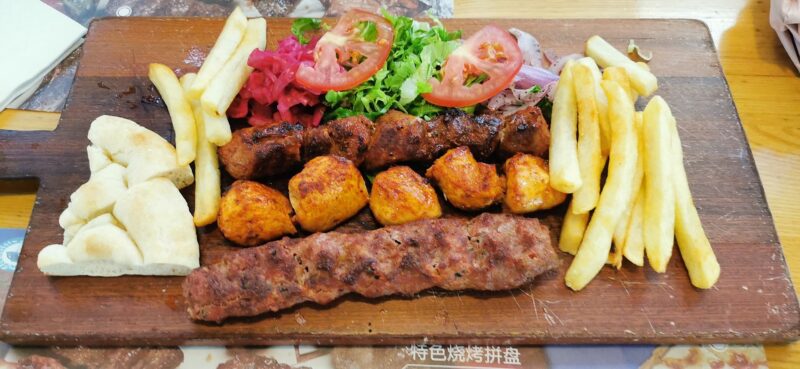
Mixed grill in Pudong Airport Turkish restaurant
Immigration & Security
After eating and around one hour before boarding was to commence, I made my way to immigration and security. Most passengers had not completed the exit health declaration, so a large group was gathered around the entrance to Customs completing it on their phones. I had my QR code ready, so walked straight past and had my code scanned and temperature recorded one final time. Exiting mainland China was quick and easy, especially since exit cards for foreigners have been eliminated in 2021.
For the security check, there were different lanes designated depending on which destination the passengers were traveling to. I joined a line for passengers on the Hong Kong flight and it was brutally slow. It seemed that not only were electronics and liquids being taken out of bags for screening, but also all cables and chargers. Most bags were going through the X-ray machine at least twice before staff was satisfied that the contents were compliant.
My rollaboard went through the machine three times as they believed I had a “tool” inside. I thought they may be seeing the internal shaft of my electric toothbrush, but after taking basically everything out of the suitcase, they finally found a small allen wrench in an external pocket of the bag. They confirmed my destination and informed me that such tools were not allowed on flights to Hong Kong. I can’t imagine what harm I could do with that little thing, but it was of no use anyway – I hadn’t even realized I had it. Clearing security took around 25 minutes, despite there being few people in that lane.
Boarding

Cathay and Etihad at Shanghai Pudong Airport
The international gate area was very quiet with virtually everything closed save one dining option. As I approached my gate, boarding had already commenced, so I got a quick shot of the plane through the window and then got in line. For boarding, only the boarding card needed to be scanned, no additional document checks required. The same gentleman who had checked me in was now scanning my boarding pass. Descending the escalator to the jetbridge, there was a transition in the attire of the airport staff. In the departures areas, staff wore normal clothes, but staff working on the arrivals level and in the jetbridge donned the traditional hazmat suits, known as Big Whites, which were a common sight during the Shanghai lockdown and which remain so in certain settings.
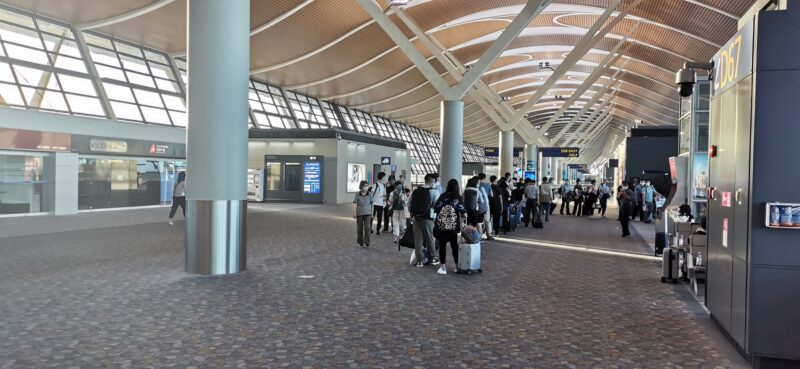
Cathay Pacific passengers boarding
I was welcomed onboard and directed to my seat. My seatmate had already boarded, so I squeezed past and took some pictures of the adjacent Ethiad 777 sporting the previous livery after settling in. I hadn’t previously realized that Cathay Pacific had taken over some of the aircraft previously operated by its shuttered Cathay Dragon subsidiary, but B-HWM, the A330-300 that would operate this flight, is one such example having been taken up by Cathay Pacific in August 2021. I had previously flown on this same aircraft in Dragonair service from Hong Kong to Hanoi back in 2016.
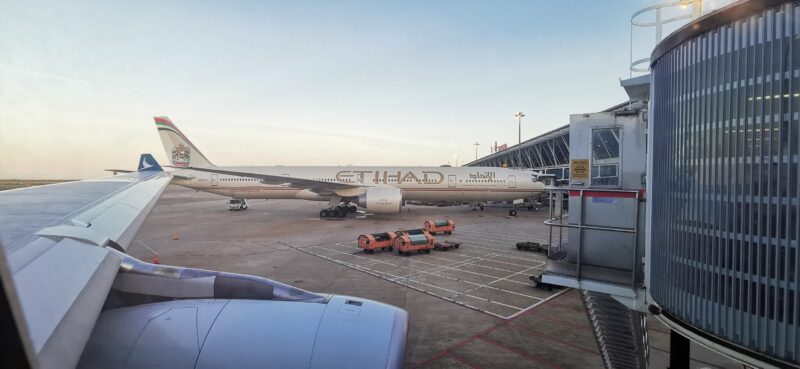
Etihad Boeing 777
I saw one man board the plane and then about 30 seconds later he frantically ran up from behind and told the flight attendants he had left his suitcase in the terminal. About 20 minutes later and after numerous radio calls on the part of the ground staff, he was reunited with his luggage. During this time, my seatmate had started watching the old Top Gun on the IFE system, but seemed to be encountering some issues with the screen. After reporting it to a flight attendant, she was allowed to move to the bulkhead seat one row forward which had a functioning screen thereby allowing me to have the row to myself. Later in the flight it was working fine, so I used it to look at the moving map while watching TV programs on my own screen.
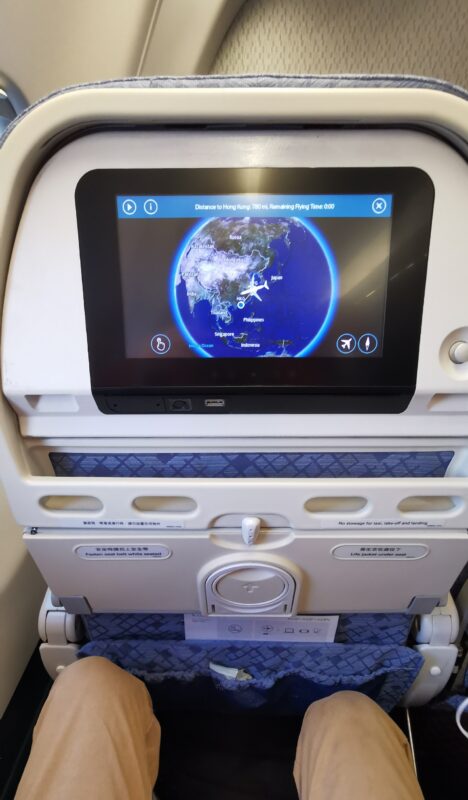
IFE system with moving map
Departure & En Route Service
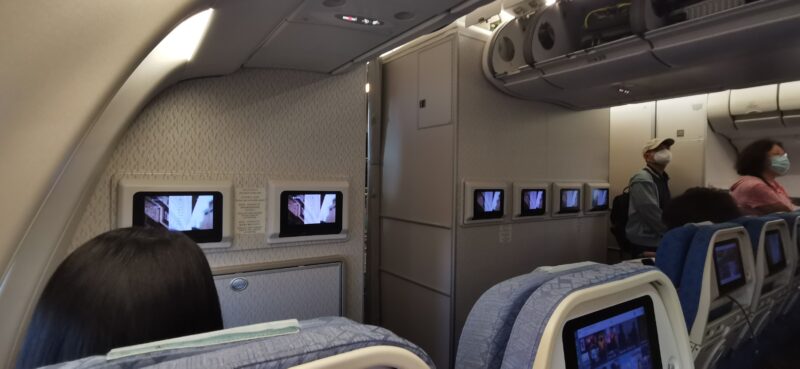
Ex-Dragonair A330-300 Cabin
The flight was maybe only 75% full and some passengers were able to use the center section of seats to lay down during the flight. The Australian cockpit crew welcomed everyone aboard in English and pushback followed soon after. By the time we commenced taxiing, it was already completely dark. We were holding short of Runway 16R in no time and were rolling at 7:38pm. On climb out, there was a good view of the COMAC plant at the south side of Pudong Airport and several newly-built ARJ21s awaiting delivery. There was also a view of the Laogang Waste Incineration Powerplant and Shengsi Island before we ended up in the clouds.
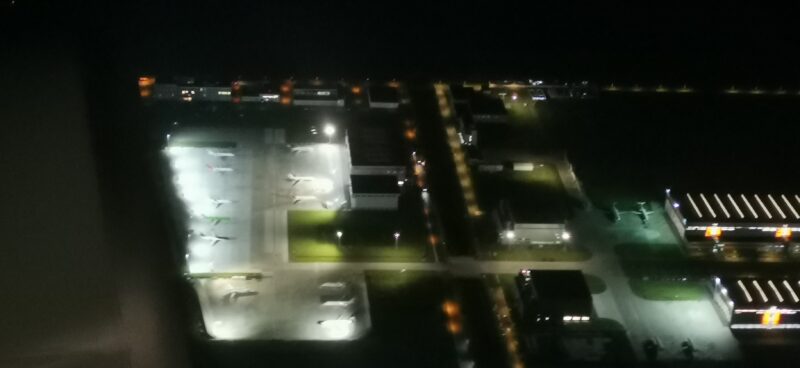
ARJ21s at Pudong’s COMAC Plant
The entertainment selection appeared to have improved since my last Cathay flight in January and I watched some sitcoms as the cabin crew began the service. Meal options were chicken with rice or fish pasta and I selected the latter with a white wine. The pasta and fish were fairly tasteless but I still finished everything, including the accompanying roll, fruit, and ice cream.
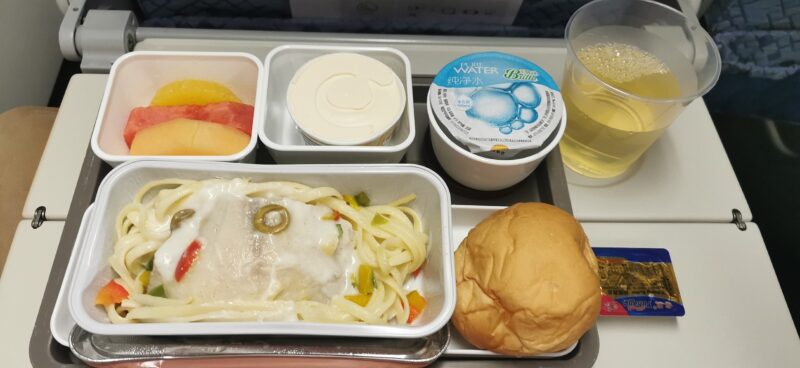
Pasta and fish meal
As the meal trays were collected, the lights of the Taiwan coastline were visible. Earlier in the week flights between Shanghai and Hong Kong had been taking a route over the Chinese mainland once south of Wenzhou, due to increased military exercises in the area, however our flight took the normal routing through the middle of the Taiwan Strait.
Descent & Arrival
As the lights of southern Taiwan passed out of view, the captain announced 30 minutes to landing and that our descent would begin soon. Shortly thereafter, a lightning show began outside and gradually intensified as we approached Hong Kong; the ride remained smooth, however. I kept my eyes out for any lights of Hong Kong, but saw nothing but darkness until we made a right turn and the bright lights of Macau and Zhuhai came into view. It was then I realized we’d be landing to the east and that we’d made our downwind leg to the south of Hong Kong and Lantau Islands. Out base to final turn offered a good view of the colorfully lit Hong Kong-Zhuhai-Macau Bridge, still devoid of traffic. We were lined up for the newly opened north runway and it struck me how much closer we were to the island of Sha Chau as we touched down some 14 minutes early at 9:41pm.

Lights of Macau and Zhuhai
From the third runway it was a very long taxi to Gate 9, crossing over the center runway now closed for an extensive rebuild. Being seated in the front of the plane, disembarkation was quick and I followed the signs for Hong Kong arrival passengers. The vast majority of passengers on this flight were transferring to other Cathay flights departing late in the evening. The top destinations were Melbourne, London, and Los Angeles, but there were also some going to Chennai as well as connecting to Qatar Airways. These passengers proceeded directly to transit security, while I was directed downstairs to the bus gate area to be transported via Cobus to the North Satellite Concourse which has been transformed into a test and hold facility dedicated to arrivals from the mainland of China. In all, this flight had just ten passengers who were ending their journey in Hong Kong. The crew was also transported to the same facility to be tested, but traveled in a separate vehicle from passengers.
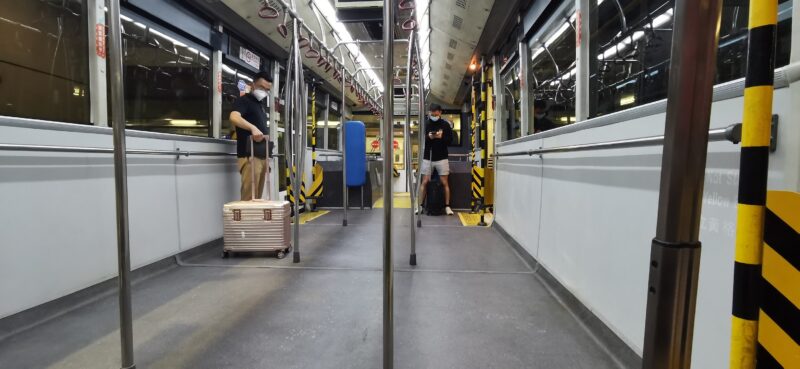
Airfield bus to testing center
Arrival Testing
Arriving in the facility at about 10:30pm, I was given a nametag and sampling bottle and proceeded to a booth to be swabbed in the nose and throat. After this, I proceeded to a desk where I presented my PCR test result from Shanghai, proof that the lab was on the approved list, my green QR code, and ID card. The staff validated my documents and printed a health monitoring checklist I should use in the following two weeks and instructed me to get tested at a Community Testing Centre on the 5th and 12th day after arrival.
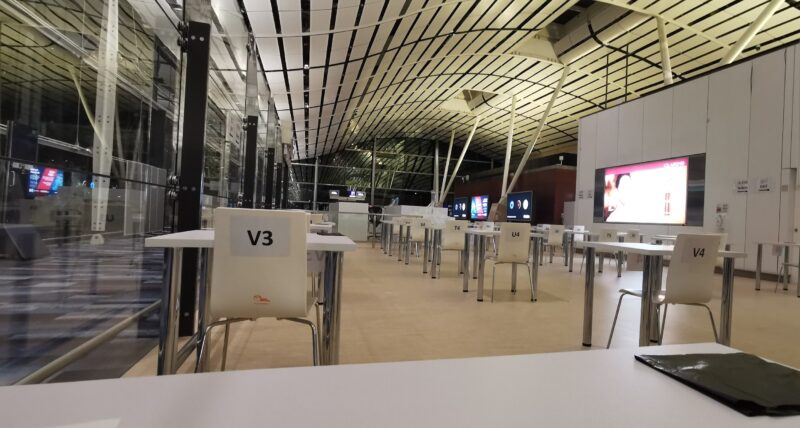
Waiting area after arrival COVID testing
From here, I went to another counter where I was assigned a seat for the roughly two hour wait until the PCR test results were returned. Passengers were split into two seating areas, one for those with Hong Kong ID cards and who successfully completed registration for quarantine free entry via the Return2HK scheme, and those who didn’t meet these requirements and thus could not obtain a green QR code. Crew waited in a third area. We could move around to go to the toilet or get snacks. We were each entitled to a choice of prepackaged sandwich, cheese crackers, and water.
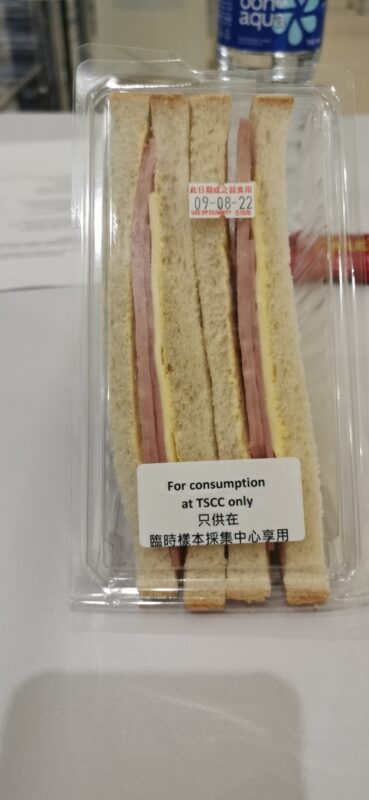
Ham and cheese sandwich provided at testing center
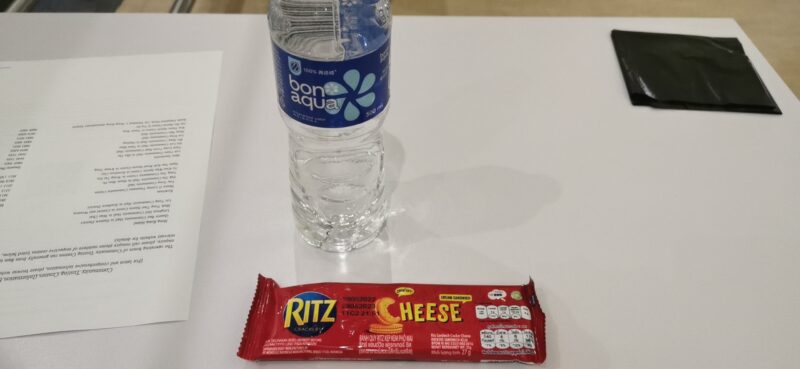
Test center refreshments
Heading Home
Once the results were out at around 12:30am and we were all deemed negative, everyone went back downstairs to the bus boarding area for the ride back to the main terminal. This time, all passengers and crew rode together on the same bus. It was my first time to reenter Hong Kong via the airport since obtaining a Hong Kong ID card, so I was impressed by the efficiency of the automated gates that only required the card to be inserted and fingerprint provided. No officer contact or passport required. The luggage from the flight had already been taken off of the carousel and neatly arranged beside it. I went directly to the Customs exit where several staff checked my paperwork to ensure I was indeed allowed to exit the airport on my own, quarantine-free. I was a free man at 1:00am and walked to the Ground Transportation Centre and waited about 20 minutes to catch a bus for the short ride home through a heavy downpour.
Complicated as this arrival process may seem, it is still a far more acceptable arrangement than the requirements for arrivals from overseas places who are still required to complete three days of quarantine in a designated hotel upon arriving in Hong Kong and subsequently complete a four-day health monitoring period during which a yellow health QR code will bar them from visiting restaurants or other high-risk venues.
